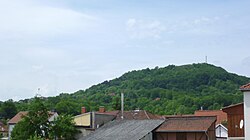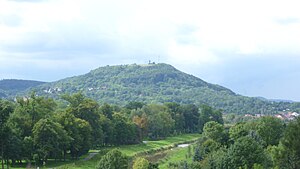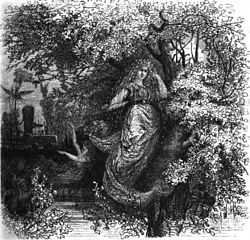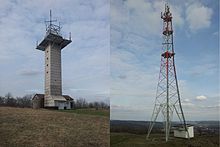Frauenberg (Sondershausen)
| Frauenberg | ||
|---|---|---|
|
Frauenberg with Sondershausen Castle Park and Wipper |
||
| height | 411 m above sea level HN | |
| location | Thuringia ( Germany ) | |
| Mountains | Hainleite | |
| Coordinates | 51 ° 22 '37 " N , 10 ° 49' 54" E | |
|
|
||
| rock | limestone | |
| particularities | pre-Christian mountain sanctuary, castle complex, church or Chapel remains, Franconian aristocratic graves, 2 transmission towers | |
The Frauenberg is a 411 m high mountain spur southwest of the district town of Sondershausen in Thuringia . It forms a section of the striking stratification of the Hainleite , which protrudes there far east into the Wippertal .
The mountain has been systematically explored through archaeological excavations since 2007 and is currently one of the most important excavation sites in Thuringia.
Geographical location
On the eastern periphery of the Hainleite ridge , the Frauenberg protrudes into the Wipper valley, in which Sondershausen is located. At the foot of the mountain are the districts of Jechaburg (south), Stockhausen (east) and Großfurra (north).
The Frauenberg plateau is almost free of forest and is partly used as a sheep pasture. The slopes, on the other hand, are wooded and overflow into allotment gardens to the northeast.
There is an old limestone quarry on the northern slope.
Surname
It is named after the former St. Mary's Church "our dear lady" on the summit plateau.
history


The settlement of the Frauenberg goes back to the Iron Age . Evidence of this are the remains of a two-post pit house that were discovered during excavations in 2010.
Also from this period, graves of a noble family were found on the plateau, richly decorated with gold jewelry, glass pearls and semi-precious stones. A silver fibula in the shape of a cross documents the transition to Christianity of the nobility then living in the region. A green tumbler, a glass bowl from the Rhineland, occupies trade around 700/800. Furthermore, 30 early medieval and 40 high medieval burials are known to date.
The foundation walls of two stone churches have been verified. That of a Romanesque stone church from the 11th / 12th centuries. Century, which Scheppig examined and buried again in 1873 , have been made visible again since 2009 using gabions . It existed until 1506 as " Capella beatae Mariae Virginis in monte b. Mariae virginis ". After Luther's Reformation , which was fruitful in the region , the church lost its importance, was plundered and fell into disrepair.
On the northern steep slope, numerous cracks run through the mountain, the formation of which is related to the geological development of the Wippertal. Allegedly an earthquake, which is said to have shaken all of Europe on January 28, 1348, is the cause of the cracks. In 1817, a huge piece of rock from such a crevice broke off on the northern slope and fell into the valley, burying numerous gardens on the mountain.
Also visible from the air is a star-shaped rampart on the plateau, which dates back to the recent past. It served as a training facility for the Schwarzburg troops under the last princes of Schwarzburg-Sondershausen .
The Frauenberg as a viewing platform was discovered quite early by the special houses and the people in the area and was (as it is today) a popular destination for hikers. This is how a restaurant was built on the Frauenberg around 1900 that lasted until the 1950s.
Archaeological site
During excavation work, the foundations of a medieval chapel were found in 1873, and the first prehistoric artifacts were also found. The favorable topography of the terrain was already used in the Urnfield period for the construction of fortifications. The mountain top has been systematically explored through archaeological excavations since 2007. A richly furnished warrior grave from the early 8th century was found. It proves that the political upper class was on the plateau so early. The mountain is currently one of the most important excavation sites in Thuringia. According to local tradition, the first settlement was followed by a cult site of the goddess Jecha in a grove . In the Middle Ages, the mountain was occupied by the first St. Mary's Church , and fortifications in the form of ramparts and moats were also found, which occupy a castle complex there.
Myths and legends
The swan in the Frauenberg
According to oral tradition, the following story was passed on. It is said that monks invented this legend of the swan to prevent people from digging for treasures that they had buried on the mountain for fear of looting. However, the legend has only been documented since the 19th century. The following is reported:
- In the mountain, which is quite hollow, there is a very large lake. An arc of heaven stretches across the lake, which is dotted with many twinkling stars, which are reflected in the clear lake. Since the beginning of the world, a silvery-white swan has been rowing in eternal circles on the calm surface of the water, living on the outflow of the stars and wearing a gold ring in its beak. When the good Lord created the earth, he put the ring in his beak so that he might keep the world in balance. When the swan drops the ring, the end of all things has come and the world will end.
Hildegard and Hellmund
The Frauenberg legend was written down as a poem by Bruno Sasse. Another version of this story based on this poem is the story by Ines Klonz Wulff-Woesten.
The legend takes place in pre-Christian times, when the goddess Jecha was worshiped on the Frauenberg and the Franconian Empire was invaded again and again by the Saxons. The main characters are a pretty girl named Hildegard and a Saxon young knight named Hellmund. Both are a couple and very much in love, until one day Hellmund has to leave Hildegard due to the war and the two of them never see each other again. The girl was so desperate that she went to the shrine of Jecha on the Frauenberg and wants to become a priestess there. She also swears that she wants to serve the goddess unreservedly. After years in a battle between Franconia and Saxony, Hellmund is captured and Jecha is to be sacrificed. As a test, Hildegard must kill the enemy with the sword. She recognizes him, but cannot and does not want to evade her duty, since he had broken her heart with his disappearance. He professes his love, but is ready to die of repentance. During a thunderstorm night on the mountain, the blood sacrifice is to be carried out. According to Sasse, the goddess Jecha is said to have been so touched that she let the earth rise and devoured the lovers. Inside the mountain was paradise and the two lived happily ever after. At Wulff-Woesten, Hildegard breaks the shackles of her lover, whereupon both of them can escape from the mountain. The anger of the goddess becomes clear in a disastrous thunderstorm, but the couple manage to escape the divine violence.
Radio technology
There are two transmission towers on the Frauenberg: an approx. 30 meter high wooden telecommunications tower that was once used by the NVA and a free-standing steel lattice tower that is used as a transmission tower for mobile radio and VHF ( MDR , Radio Top 40 ).
Remarks
- ↑ In the next few years, seating, display boards, etc. Ä. planned for presentation.
literature
- FJB Leonhard: The Harzburg and its history. Fleckeisen, Helmstädt 1825.
- CA Vulpius : Concise dictionary of the mythology of the German, related, neighboring and Nordic peoples. Lauffer, Leipzig 1826.
- Ludwig Ettmüller : Kunech Luarin. Besides noticing. Schmid, Jena 1829, online .
- Georg Quehl: The religion of the Thuringians. First part: The paganism of the Thuringians - containing the entry and first spread of Christianity in Thuringia, and the presentation of the Preacher Church in Erfurt. Commissioned by Keyser Buchhandlung, Erfurt 1830.
- Michael Köhler: Thuringian castles and fortified prehistoric and early historical living spaces. Jenzig-Verlag Köhler, Jena 2001, ISBN 3-910141-43-9 .
Individual evidence
- ^ Announcements from the Association for German History and Antiquity in Sondershausen 6th issue , Sondershausen 1931, p. 21
- ↑ Insights into the early Middle Ages. The Frauenberg near Sondershausen was an important center of power. In: Monuments Online 2.2014. Retrieved April 1, 2014 .
- ↑ Hidden Christian traces in the soil of the Frauenberg. (No longer available online.) In: Musik- und Bergstadt Sondershausen (online portal of the city administration). Formerly in the original ; Retrieved August 22, 2010 . ( Page no longer available , search in web archives ) Info: The link was automatically marked as defective. Please check the link according to the instructions and then remove this notice.
- ↑ Wolfgang Diez and Helmut Röttig: Sondershausen declaration of love to a city , Röttig picture archive, Sondershausen 2000, p. 229
- ^ The saga of Frauenberg, Bruno Sasse, Fr. Aug. Eupel's Hofdruckerei, Sondershausen 1910
- ↑ Hildegard and Hellmund - the saga of Frauenberg, WRITING & GRAPHICS Luzie Aweh, Sondershausen 1997




